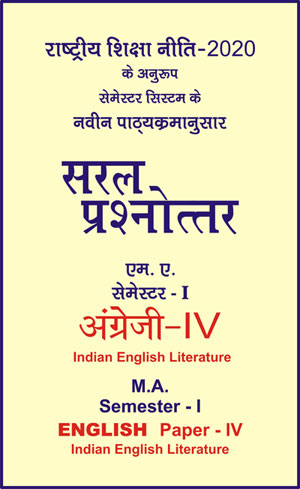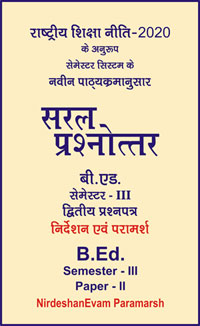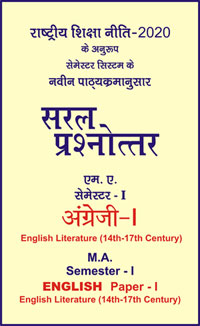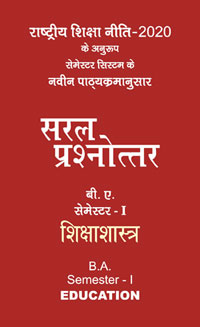|
बी ए - एम ए >> एम ए सेमेस्टर-1 - अंग्रेजी - चतुर्थ प्रश्नपत्र - इण्डियन इंगलिश लिटरेचर एम ए सेमेस्टर-1 - अंग्रेजी - चतुर्थ प्रश्नपत्र - इण्डियन इंगलिश लिटरेचरसरल प्रश्नोत्तर समूह
|
|
|||||||
एम ए सेमेस्टर-1 - अंग्रेजी - चतुर्थ प्रश्नपत्र - इण्डियन इंगलिश लिटरेचर
Unit - III: Poetry
Chapter - 6
"The Harp of India”.
- Henry Derozio
Question- Critically appreciate the poem The Harp of India'.
Answer -
This is one of the most iconic poems of Derozio. In the first glance it might be just read as any other fourteen line poem, but the inclusion of the words 'Harp' and 'India' stimulates us to delve deeper into the contents of the poem. 'Harp' is a musical instrument mostly endemic to Ireland in the past two or three centuries, so how does it relate with a colonised country (in Derozio's time) like India? Also, the inclusion of the word 'India' as a seemingly separate independent unit in pre-independent era is indicative of much more than what is visible or apparently comprehensible. It also must be taken into account here that Derozio was of Indo-Portugese origin, and the usage of India' in such a prominent manner can only indicate that not only did Derozio take India as his home country but was also concerned about the shackled state of India under the dominion of the British and along with the hope that the music of India be restored and her dignity and glory be strung again.
In India, the 'Harp' was the first musical instrument played by the Tamil people around 200 B.C., as documented by the Sangam Literature. Bearing this strain of thought we might also relate that Derozio has used 'Harp' as a means to portray the rich and varied culture of traditions that India possessed and which were now being suppressed by the British Raj. The poet seems to echo the reverberations likewise in the 3rd line, Thy music was once sweet who hears it now, implying that the rule of the British was actually a foil to India's own native heritage and the rhythm and music of such a rich tradition has been subdued if not completely erased.
There can be other speculations as to why Derozio has used 'Harp' and not any other instrument in its place. Bengal itself had a very interesting 'harp' culture in the past. There are numerous instances of carved harps in the temple reliefs of Bengal dating back to before 500AD but then the questions as to whether Derozio was privy about this or not. This is left to speculation itself.
This poem can be read as a sonnet but is different from the conventional sonnets with a rhyme scheme of 'a-b-a-b-b-a-b-c-d-c-d-c-b-b' and the poem begins with a question 'why hangs't thou lonely on yon withered bough?' but why does the poet begin with a question? During Derozio's time the British had completely colonised not only the physical being of the Indians but also the mental capabilities of the Indians were kept in shackles. This situation is adequately portrayed by Derozio in the opening line as questions were often thought of but never expressed due to the fear of Britishers. This single line portrays the psyche of a native Indian who has been both physically and mentally colonised by the Britishers and Derozio at the same time is questioning through the same confines of the same line as to the 'causes for such mental conolization too.
In the question 'why hang'st thau lonely on yon withered bough?' - 'thou' can be intepreted in a dual way, if we relate it with the title of the poem, it seems that 'thou' is being referred to a harp which is hanging from a shrivelled tree branch. This 'thou' can also be interpreted as a personification of the Indian natives who are being 'hang'st' by the British in withered India.
The entire constitution of the poem is an evolutionary process from being listless and gloomy to a gradual forceful build-up of yanking the causes of gloom away and replacing it by fervour and optimism for making things better. The usage of the words 'lonely', 'withered', 'unstrung forever' indicate a gloomy opening as the poet engages us to visualise an image of a neglected harp hanging on the almost dead branch. We are forced to consider and ponder the future of this listless harp 'Why is this harp left unstrung? Can this abandoned harp sing again?"
He continues through his reproachful broodings and conveys to us that this instrument was a harbinger of sweet melodies but, now that it is 'unstrung', the melodies are dormant, even the breeze blows over it unable to woke the harp from its stupor. One can easily image a young lad of age twenty approximately staring up at gulmohar and seeing the rusted old unstrung harp on the upper boughs and longing for its music to echo in the meandering passages of the oreille. There is a sense of concern while at the next instance there is a strong sense of ire in the poet when he says 'who hears it now'. The poet in order to convey both these contrasting emotions in a justifiable manner has used a hyphen. The shift from concern to ire is through the hyphen.
In the lines 5th and 7th of the poem, there is a shift in the setting of the poem and the poet has used imagery modifications and metaphor depictions and personification technique to emphasise the continuation of the thought that he wants to project. 'Silence hath bound thee with her fatal chain'. The 'thee' in this line is obviously a continuation of the thou' in the 1st line and it points to the same harp, but the point of interest - here is the 'silence' and 'her' words. 'Silence' is definitely a personification if we consider collaborating the meaning of 'her' in the same line. The poet has intended to show that 'Silence' is a female entity (due to the use of personal pronoun 'her') binding the harp to almost its death. It can also be stated that Derozio could easily have used the word 'death' instead of using 'silence' as the way he projects the harp in the previous line. But the word 'silence' makes it clear that the harp is just not making its presence felt instead of being completely non-existent. The death like silence has neglected and muted the harp and made it as useless as a 'ruined monument'. (7th line) in a desert. The imagery of the harp being in a similar state to ruins in a desert has three inferences regarding its past ('ruins'), a miserable prevent and uncertain future.
From the 8th line onwards, we find a shift in the focal point of the poem; it has now shifted from the 'unstrung' harp to the strummers and singers of the harp. There is also a shift in the poet's attitude as well. The poet seems conscious of a difference. For the harp, not for the ruin, however, there is a future as there is a strong possibility of the mute instrument regaining its power once able hand touch its strings.
Derozio laments the fact that in the desolate times of India, there is no significant poet to ignite the zeal and positivity to the native Indians. The poet shifts from the instrument to the strummers i.e. the great poets who once transfixed the listeners with their poetic brilliance. Their hand 'more worthy far' than his own, says Derozio, modestly had struck at the 'harmonious chords' in the past and the harp had then produced notes powerful enough to both enliven listeners and confer on the poets a kind of mortality. Though in their graves bodily, there maters remain alive through their act.
In colonised India, there was great requirement to instill the confidence in the natives against the British rulers. The poets of the past were all departed but if there was any chance that the harp could again be restrung and the musical notes could again be played then Derozio himself wants to take-up the once for such a revival. There is almost a great urgency portrayed by the poet to ignite this revival and the poet seems impatient to release India from its bound form. This is shown from the use of exclamation after the end line. Therefore, we find a plethora of emotions and aspirations that the poet has portrayed through the medium of words used and the case markings used. Just as the thoughts in our brain seem to jump to the next, Derozio has also carefully aligned to the same by overlapping two similar image settings having the same strain of gloomy thought, firstly; the unstrung harp on a withered bough and secondly, the desert ruins.
While Derozio's language is reminiscent of Byron and Moore, his ardent love for his country, his passion for social reform, and his tender and courageous humanity, are inventively his own. The intensity of feeling expressed in "The Harp of India' and the poet's firm conviction that his India will one day regain her past glory leave readers in no doubt that there was nothing foreign about the poet except his name over which, unfortunately he had no control.
|
|||||
- Question- Write about Post-Colonial Indian writings in English Literature?
- Question- What is Postmordanism in English Literature?
- Question- Write an essay Postmoderism's influence of Indian writing in High Ab Han English Literature?
- Question- What is Dalit Literature?
- Question- Write about Dalit's voice: A voice from the Margin?
- Question- Write the development of Indian English Poetry, since the 1980s.
- Question- What is experimental Theatre?
- Question- What is Indians in Indian "English Literature”?
- Question- Define the term 'Indian English Literature'?
- Question- What is contemporary poetry in English Literature?
- Question- What is India drama in English Literature?
- Question- What is experimental Poetry?
- Question- Write about the origin of structuralism and Post-structuralism.
- Question- Write the theory of Post-modernism.
- Question- What do understand by the post-colonialism?
- Question- Write the influence of Postmoderanism on English Literature?
- Question- Write about the Renaissance in India and other essays on Indian culture.
- Question- Write about Renaissance in India and the nature of India culture as explicated by Sri Aurobindo.
- Question- Who is Sri Aurobindo? Give an introduction of him.
- Question- What are the ideas on Indian culture of Aurobindo, given in his essay 'Indian culture and external influence'?
- Question- Write an introduction of Dr. Sarvepalli Radhakrishnan. with whole life.
- Question- What is Idealism?
- Question- Write an introduction of 'An Idealist View of Life' by Radhakrishnan.
- Question- How does an idealist view life?
- Question- Write an introduction of Nirad C. Chaudhari.
- Question- Write the background of the book 'A passage to England' by C. Chaudhari.
- Question- Write a summary of 'A Passage to England' with giving an introduction of book. and describe 'The English Scene'.
- Question- What is the purpose of Chaudhari to write 'A Passage to England?
- Question- Write a short note on the life and works of Mrs. Meenakshi Mukherjee.
- Question- What do you know about The Perishable Empire : Essays on Indian writing in English' by Meenakshi Mukherjee?
- Question- Critically appreciate the poem The Harp of India'.
- Question- Give a brief life sketch of Henry Derozio.
- Question- Write a short note on Young Bengal Movement.
- Question- Provide a brief background of the poem 'The Harp of India'.
- Question- What do you know about part 1 of the poem?
- Question- What do you know about part 2 of the poem?
- Question- What impact has the prevailing conditions of the times made on India in the poem 'The Harp of India'?
- Question- Expalin with reference to the context any two of the following passeges.
- Question- Write a critical appreciation of 'Love Poem for a Wife' by A. K. Ramanujan.
- Question- In which style 'Love poem for a wife' is written? Explain.
- Question- Expalin with reference to the context any two of the following passeges.
- Question- Who is R. Parthasarathy? Write about his life and career.
- Question- What is the summary of the poem 'Exile from Homecoming"?
- Question- Write a Critical appreciation of the poem 'Exile From Homecoming'.
- Question- What has happened to poetry and why?
- Question- Why does the speaker recommend newspapers?
- Question- What is the introduction of 'Exile From Homecoming'?
- Question- Expalin with reference to the context any two of the following passeges.
- Question- What is the introduction of the poem 'Palanquin-Bearer'?
- Question- What is the critical appreciation of "The Palanquin Bearers'?
- Question- Write life and works of Sarojini Naidu.
- Question- What is the message in Palanquin Bearers by Sarojini Naidu?
- Question- What is the mood, tone and setting of the palanquin Bearers?
- Question- What is the Summary of the poem The Palanquin Bearers'?
- Question- Expalin with reference to the context following passege.
- Question- Write life and works of Shiv K. Kumar.
- Question- Write a note on Shiv K. Kumar as a poet.
- Question- Write a critical appreciation of the poem, 'Pilgrimage'.
- Question- Expalin with reference to the context following passege.
- Question- What do you know about Dom Moraes?
- Question- What is the summary of the poem "Bells for William Wordsworth".
- Question- Expalin with reference to the context following passege.
- Question- What is the summary of the poem Tribute to Papa' by Mamta Kalia?
- Question- Mamta Kalia's poem Tribut to Papa' is quest for an identy. Write about it?
- Question- Expalin with reference to the context following passege.
- Question- Explain how myth and symbolism are integral parts of Raja Rao's fictional act in Kanthapura.
- Question- What are the main features of Raja Rao's narrative technique in Kanthapura?
- Question- The three levels of action in Kanthapura-political, social and religious are all related to a unified concept of India. Discuss the structure of the novel in the light of the statement.
- Question- Provide a summary of the novel 'Kanthapura'.
- Question- What are the important themes one can find in Kanthapura?
- Question- Place Raja Rao in the context of the evolution of the Indian writing in English.
- Question- What do you know about the historical and political background of Kanthapura?
- Question- How deep and wide is the impact of Gandhi's personality and his thought on the theme of Kanthapura?
- Question- What do you know about Kanthapura and its people?
- Question- What is the significance of the Skeffington Coffee Estate in the overall account of the village in Kanthapura?
- Question- What are those qualities that go into the making of Moorthy, the central figure in Kanthapura?
- Question- What do you think of the women characters in Kanthapura? What is their role in the action of the novel?
- Question- How successful is Moorthy in leading his followers in the Satyagraha movement of the village?
- Question- Write a short essay on 'Considerations of Caste' in Kanthapura.
- Question- How successful is Achakka, the narrator in her attempt to tell the story of her village in the context of the Satyagraha movement?
- Question- Comment on some of the male character - other than Moorthy in Kanthapura.
- Question- What are some important themes in the novel 'The Guide'?
- Question- Provide a detailed character sketch of Raju (The Guide).
- Question- Can The Guide' be called a picaresque novel?
- Question- Comment on the narrative technique in "The Guide'.
- Question- Unravel the various aspects of Rosie's character in the light of the novel.
- Question- Sum up the literary elements found in the novel.
- Question- How is the concept of universality explored in the novel?
- Question- Write a short note on R.K. Narayan.
- Question- What do you know about Raju from 'The Guide'?
- Question- Give a brief character sketch of Rosie.
- Question- What importance does the town 'Malgudi' carry in most of the novel of R.K. Narayan?
- Question- Give a brief character sketch of Marco.
- Question- Write a brief character sketch of Velan.
- Question- How is title of the novel 'The Guide' appropriate?
- Question- Critically analyze the novel The Guide.'
- Question- Is Raju a transformed man by the end of the novel?
- Question- Is Velan a mere fool or a major accessory to Raju's transformation?
- Question- What roles do dharma and Karma play in the text?
- Question- What are the some important metaphors we come across after reading in the novel?
- Question- Write about the whole life of Shashi Deshpande with works.
- Question- Shashi Deshpande's craft as a novelist a study with special reference to 'That long Silence'
- Question- What is theme of the novel 'That Long Silence'?
- Question- Describe Jaya's Quest for self in "That Long Silence' by Shashi Deshpande.
- Question- What do you mean by the title of the novel 'That Long Silence'?
- Question- What is the introduction of Shashi Deshpande?
- Question- What is 'That Long Silence' about?
- Question- What is the relationship between Jaya and Mohan in the "That Long Silence'?
- Question- Who always reminds Jaya That husband is like sheltering tree?
- Question- Who is Kamat in the novel 'That Long Silence'?
- Question- What is the Indroduction of Firdaus Kanga's 'Trying to Grow'?
- Question- Analysis of Trying to Grow' by Firdaus Kanga.
- Question- Describe of Parsi Community in "Trying to Grow' by Firdaus Kanga?
- Question- Who is Firdaus Kanga?
- Question- What is the major achievement of 'Firdaus Kanga'?
- Question- Write about the sixth Happiness, BFI/BBC Film in 'Trying to Grow' by Firdaus Kanga.
- Question- Write life and works of Arundhati Roy.
- Question- How has Arundhati Roy projected the illicit or incestuous relations in 'The God of Small Things'?
- Question- Evaluate The God of Small Things' as a tale of confrontation as its theme.
- Question- Give a brief character sketch of Estha and Rahel.
- Question- Why did the relationship of Ammu and Velutha came to an abrup end?
- Question- Relate the atrocities faced by Ammu all her life and her insignificant end?
- Question- Describe the Roy's use of symbols and images in her novel.
- Question- Write the life and works of Ilavenil Meena Kandasamy.
- Question- What is the introduction of the novel 'When I Hit You?
- Question- Describe the portrayal of domestic violence in 'When I Hit You?
- Question- Write about The Feminism in 'When I Hit You?
- Question- What is the summary of the story "Two Lady Rams"?
- Question- Write a note on Indian-ness in "Two Lady Rams' by Mulk Raj Anand.
- Question- What is the significance of the Title 'Two Lady Rams'?
- Question- Who was the first wife of Lalla Jhinda Ram?
- Question- Who is Lalla Jhinda Ram?
- Question- Analyse the story "Two Lady Rams'.
- Question- Write about the life of Salman Rushdie.
- Question- Write about the carrer of Salman Rushdie.
- Question- Write the summary of the story "Free Radio" by Salman Rushdie.
- Question- Who was the narrator in the short story "The Free Radio'?
- Question- Justify the title of the story "The Free Radio'.
- Question- Who is Ramani and what is the role of Ramani in this story "The Free Radio'?
- Question- What is the introduction of the story 'The Free Radio'?
- Question- Why is the narrator so much concerned for Ramani?
- Question- What does the Free Radio Symbolize in the story free radio'?
- Question- Write about the sexism in the story 'The Free Radio'?
- Question- Write a summary of the story 'The Intrusion'.
- Question- Analyse the story "The Intrusion' as a quest for identity
- Question- Write about the human predicament and emotional suffocation in Shashi Deshpande's short story "The Intrusion'.
- Question- Write the justification of the title "The Intrusion.'
- Question- What does the wife want in the story "The Intrusion'?
- Question- Who is the intruder in the story 'The Intrusion'?
- Question- What is the summary of the story 'Diamond Dust' by Anita Desai?
- Question- Write about the themes of 'Diamond Dust' by Anita Desai.
- Question- Who is Mr. Das in the Story 'Diamond Dust'?
- Question- What is the role of Mrs Sheila Das in 'Diamond Dust?
- Question- Who is Diamond in the story 'Diamond Dust'?
- Question- Attempt a critical appreciation of Vijay Tendulkar's play, Silence! The Court is in Session.
- Question- Attempt an essay on Tendulkar's delineation of women in his play, silence! The court is in Session.
- Question- Discuss Tendulkar's humour satire and irony in 'Silence! The Court is in Session.'
- Question- Justify the title of Vijay Tendulkar's play, Silence! The Court is in Session.
- Question- Write a short note on the role of Sukhatme in the mock-trial in Tendulkar's play, Silence! The Court is in Session.
- Question- Wite the character sketch's of Mr. Kashikar.
- Question- Give a short account of Miss Benare as a teacher.
- Question- What verdict does Kashikar give in Benare's case?
- Question- Write a short note on Balu Rokde.
- Question- Bring out the significance of prof. Damle in Silence! The Court is in Session.
- Question- How does Tendulkar's play, Silence ! reveal society's partiality towards woman?
- Question- Life and work of Grish Karnad.
- Question- What is the introduction of 'The Fire and the Rain'?
- Question- Discuss the central themes of Girish Karnad's play, 'The Fire and the Rains'.
- Question- Write a character sketch of Yavakri.
- Question- Write a critical note on Paravasu-Vishakha relationship.
- Question- Write a character sketch Raibhya.
- Question- Comment on the significance of the role of the Actor Manager in "The Fire and the Rain'.
- Question- Wha is the theme of 'The Fire and The Rain'?
- Question- Who is Raibhya in "The Fire and The Rain'?
- Question- Who is Andhaka in the 'The Fire and The Rain'?
- Question- Who is Arvasu?
- Question- Write a note on the life and works of Manjula Padmanabhan.
- Question- Write the summary of 'Harvest' by Manjula Padamanabhan.
- Question- Write a note on Themes and Techniques in Manjula Padmanabhan's plays.
- Question- Who is the man character of the play 'Harvest'?
- Question- Who is Jaya in the story 'Harvest'?
- Question- How does Ginni control Om and his family?
- Question- Who is Ginni in the play 'Harvest'?
- Question- Discuss the theme of exploitation in the play 'Harvest'.

 i
i 










